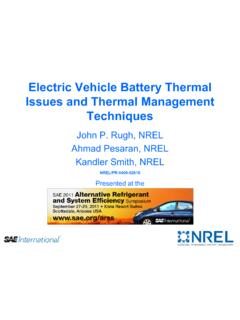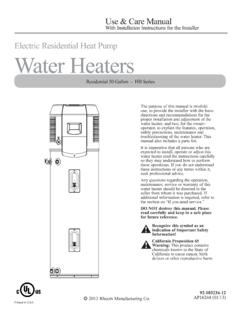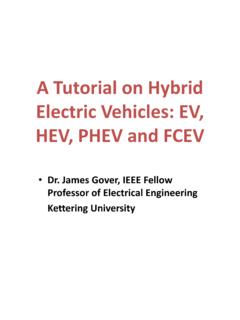Transcription of NASA Hybrid Electric Aircraft Propulsion
1 NASA Hybrid Electric Aircraft Propulsion1Dr. Rodger DysonNIEA Biomimicry SummitHybrid Gas Electric Propulsion Technical LeadNASA Glenn Research CenterCleveland, OHOct. 4, 2017 Electrically Enhanced Propulsion Why Electric ? Fewer emissions Quieter flight Fuel savings New mobility options Better utilization of infrastructure3 Aircraft Energy SourcesJet Fuel is Light-Weight and Low-CostRequired mission power level determines energy source(~2% burnup)ElectricallyEnhanced Propulsion Well to Wake Energy Benefit Fuel Savings Noise Reduction Carbon and NOx Reduction Mobility and SafetyPowertrain EfficiencySystem Benefit39%, 33%, 21%, 13%Well to Wake7-12%Well to WakeAll & Hybrid Electric ,Distributed Propulsion On Demand Mobility Small Plane FocusedTurbo Electric ,Distributed Propulsion Fuel Efficient Propulsion Transport Class FocusedEnable New Aero Efficiencies Power SharingDistributed Thrust ControlCertification TrailblazingEnergy & Cost Efficient, Short Range AviationEnable New Aero Efficiencies High Efficiency Power DistributionPower Rich OptimizationNon-flight Critical First ApplicationEnergy & Cost Efficient.
2 Transport AviationOn-Demand and Large TransportSUGAR VoltRange of Required Machine Power SuperconductingNon-cryogenic100 kW1 MW3 MW10 MW30 MWPS 01758 111519 Seat2 MW Total Propulsive Power300 Seat60 MW Total Propulsive Power9 Seat MW Total Propulsive Power50-250 kW Electric MW Electric Machines50 Seat Turboprop 3 MW Total Propulsive MW Electric Machines150 Seat22 MW Total Propulsive Power1-11 MW Electric Machines3 -30 MW Electric MachinesLargest Electrical Machine on Aircraft50 Seat Jet12 MW Total Propulsive Power150 Seat22 MW Total Propulsive MW Electric MW Electric MachinesLeft side of each power range bar is the smallest motorthat yields overall aerodynamic efficiency increase for a partially electrified airplaneRight side is the size of a generatorfor a twin turboelectric system for a fully electrified airplaneTechnology: Powertrain Components Electric machines Power electronics Integrated turbines, generators Controls TransmissionTechnology: Enabling Materials and Devices Insulation Conductors Magnetic materials Power electronics devicesFull-Scale Ground Tests: NASA Electric Aircraft Testbed (NEAT)Aft boundary ingesting Electric motor Technology: Vehicle and Propulsion concepts and benefits studiesX-Planes: Near and Mid-termNASA Electrified Aircraft Technology (NEAT)Goal.
3 Flight tests, ground demo s and technology readiness by 2025 to support 2035 Entry into Service Design and test electrified airplane powertrainsthat are flightweight, safe, reliable, fault tolerant NASA s STARC-ABL configuration to betested in NEAT testbed in 2018 at full power Regional Jet or Single Aisledemo before 2025 Thin Haul Commuter Low cost fixed wing verticaltake-off and landing (VTOL) Maxwell X-57 (battery,distributed)Near Term Propulsion OptionsParallel -Motor with Engine Turboelectric Motor DistributedVehicle Configuration Trade-offs9 VEHICLE CONFIGURATION EXAMPLES Battery vs. Turbine Power Aerodynamics vs. Complexity Voltage vs. Efficiency Thermal vs. Mass Stability vs. Integration10 Powertrain System Optimization2nd Stage1st StageLow pressureHigh pressureElectricalAn optimization of the whole system has to be done in order to reach the minimum weight and/or volumeTail-cone Thruster PropulsionTail-cone Motor Thruster concept 150 passenger plane with two turbines and Electric motor driven tail cone thruster 7-12% fuel burn reduction Uses jet fuel, standard runways & terminalsIMPACT.
4 Reduce fuel use and emissions of biggest Aircraft segment Key Technologies Aircraft System Analysis modeling, analysis compared to key metrics Engine technologies >1 MW power extraction from turbofan Propulsion /Airframe Integration benefit of tail cone thruster (takeoff to Mach) Power >1 MW efficient, high specific power Materials turbine, magnetic materials, cable materials, insulationAircraft Energy StorageCan choose high energy or power, mass is a challenge NASA Sponsored Motor Research NASA In-House Motor Research Analytical Studies and Prototype Testing focused on ultra-high efficiency 99% 1MW Specific Power > 8HP/lb( ) Efficiency > 96% Awards University of Illinois Ohio State University Phase 3 to be completed in 2018 Electric Machine DevelopmentYear 1 Technology Demo.
5 Prototype Motor PartsPower Electronics Development NASA Sponsored Inverter Research 1MW, 3 Phase AC output 1000V or greater input DC BUS Ambient Temperature Awards 3 Years (Phase 1, 2, 3) GE Silicon Carbide Univ. of Illinois Gallium Nitride Cryogenic Temperature Award 4 years (Phase 1, 2, 3) Boeing Silicon CoolMOS, SiGe NASA In-House Inverter Research Designing 14 kW Inverter based on HEIST motor and nacelle cooling and packaging requirements 99% efficiency driven by cooling requirementsKey PerformanceMetricsSpecific Power (kW/kg)Specific Power (HP/lb)Efficiency (%) PerformanceMetricsSpecific Power (kW/kg)Specific Power (HP/lb)Efficiency (%) Inverter RequirementsCryogenic Inverter Requirements15 Power System Weight DriversMagnetic MaterialsInsulation MaterialsHigh Conductivity MaterialsElectric Powertrain Materials Aircraft Power/Cooling OptionsTrade-space includes.
6 Motor & Inverter Topologies Thermodynamic Cycles Storage and Regeneration Energy Source and Recycle17 Thermal ChallengeCurrent proposed solutions (and limits) include: Ram air HX adds weight and Aircraft drag Convective skin cooling HX adds weight, drag, and inefficient Dumping heat into fuel limited thermal capacity Dumping heat into lubricating oil limited thermal capacity Active cooling adds weight and consumes engine power Phase change cooling adds weight and limited thermal capacity heat pipe, pumped multiphase, vapor compression adds weight and consumes engine power50kW to 800kW of low grade thermal power trapped within composite Aircraft bodyNatured-Inspired Integrated Power, Propulsion ,ThermalSTARC-ABLDARPAECO-150 Several powertrains installed adjacentlyAero-vascular Energy ManagementHuman HeartArtery VeinSkin BloodAircraftTurbofan Acoustic PipeHeat Pipe SkinHelium/GasLarge Aircraft ideal for integration-allows each component to be at knee in the curve instead of Achilles Heal of vehicle Turbofan-45% eff.
7 Powertrain-95% eff. Lifting surface ODM = city noise and traffic complexity Large transport highest impactHuman body circulatory system as model for Aircraft Three pillars: recycle, additive manufacture, integration/control20 Energy transport with ducted acoustic wave21 Recycling Thermal EnergyAreas where heat can be extracted or inserted for net efficiency gain in turbofan heat Recovery CycleBy-pass Air heat ExchangerEngine Core heat Exchanger Airframe heat ExchangerHeat Pipe ExchangerStackResonatorResonatorStack23 Variable Conductance heat Pipe for Controlled heat DeliverySolid-state (no moving part) energy recycle and control Localized skin heating for active lift/drag management, de-icing, powertrain cooling, cabin management, and military cloakingSolid-state heat flow control to heat pump and combustorTurbine Waste Energy Transmitted Acoustically, Powertrain Waste Energy heat Pipe Delivered to CombustorNo moving part heat reuse and recycleConclusions Key Power, Energy Storage and Conversion Technologies are being developed that support On Demand Mobility and Transport Class Aircraft : MW Motors and Inverters can support transport Propulsion requirements Energy Storage technology can safely support on demand mobility Energy Conversion technology can thermally recycle all Aircraft waste heat Hybrid Gas Electric Propulsion technology enables.
8 Heavier payloads, Noise, emission, and operational cost reduction New mission capability including duration and durability Challengesinclude: Operational and regulatory change requirements EMI standards and flight path management Dispatch ability and InfrastructurePower Technology is maturing at a fast pace! Key Features Include: Turbofan waste heat is used to generate ducted acoustic waves that then drive distributed acoustic heat pumps and/or generate power. Low grade powertrain waste heat is converted into high grade recycled heat and returned to the engine combustor via heat pipes Pressurized acoustic and heat pipe tubes can be directly integrated into the airframe to provide structure support with mass reduction. Fuel savings of 16% are estimated with a purpose-built system All Aircraft heat is rejected through engine nozzle Non-provisional Patent Filed With Priority Date November 6, changes Aircraft thermal management from being a necessary burden on Aircraft performance to a desirable asset.
9 It improves the engine performance by recycling waste heat and ultimately rejecting all collected Aircraft heat out through the engine you for attending!Any Questions?26









